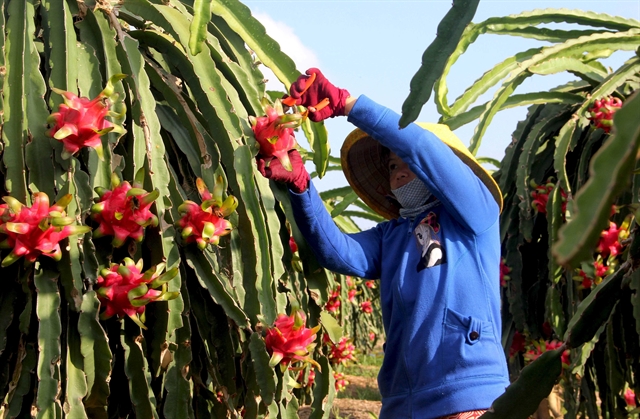 Economy
Economy

 |
| Harvesting dragon fruits for export in Long An Province. Việt Nam hopes to be allowed official export of dragon fruit to China this year. — VNA/VNS Photo |
HÀ NỘI — China is the largest export market of Vietnamese fruits and vegetables, accounting for nearly 65 per cent of the total fruit and vegetable export value, according to Đặng Phúc Nguyên, general secretary of the Việt Nam Fruit and Vegetable Association.
Besides durian, Việt Nam hopes to be granted official export permission for jackfruit and dragon fruit to this market from now to the end of this year.
With increasing quality, Vietnamese fruits are popular among Chinese consumers. The fruit exports are forecast to maintain growth, especially with increasing demand during the holiday season.
Last year, Việt Nam signed fruit protocols with China, bringing many advantages to Việt Nam's fruit and vegetable export activities.
Phùng Đức Tiến, Deputy Minister of Agriculture and Rural Development, said that Việt Nam would continue to negotiate with China on protocols for many products, including watermelon, frozen durian, chilli, medicinal herbs and citrus fruits.
Watermelon, in particular, has been traditionally exported via border gates, so the signing of the protocol would remove problems and create more favourable conditions for Việt Nam to increase watermelon exports.
Regarding export prospects to China in the last months of the year, MoIT said the export of fruit and vegetable products, including durian, watermelon and frozen fruit, was expected to continue to grow. Meanwhile, dragon fruit and mango exports were likely to decline as China increases domestic supply.
Việt Nam still has room for growth of agricultural product exports to China, because the products meet the increasingly strict quality requirements of this market.
According to World Bank forecasts, China's economic growth will recover to 5.6 per cent in 2023. Therefore, agricultural exports to this market are expected to increase slightly from now until the end of the year. Of which, some products such as vegetables, rice and cashews still maintain their growth rate, while seafood, wooden furniture and cassava products may recover only slightly.
Experts have recommended that to increase fruit exports to China in the coming years, key issues are fruit quality control and compliance with China's regulations on coded growing areas and coded export enterprises.
Therefore, Hoàng Trung, Deputy Minister of Agriculture and Rural Development, said the ministry requested provinces and cities to carry out inspection and supervision of growing areas and packaging facilities that had been granted codes.
At the same time, they would need to strengthen the publication of Chinese regulations, as well as issue technical guidance to the Plant Protection Department for producers and exporters of products shipped to China.
According to MARD, the export value of fruits and vegetables in the first eight months of 2023 reached US$3.45 billion, up 57.5 per cent over the same period last year, reported the Thời báo Tài chính (Financial Times) newspaper.
The items that accounted for a high proportion of fruit and vegetable exports were durian (35 per cent), dragon fruit (13 per cent), bananas (6 per cent), mango (6 per cent), and jackfruit (5 per cent). China had a high demand to import those products.
MARD quoted data from the General Department of Customs of China saying that China’s durian imports in the first half of this year reached 787,000 tonnes, worth $3.83 billion, up by 57.1 per cent and 64.9 per cent respectively, over the same period last year. The main suppliers were Thailand (600,000 tonnes), Việt Nam (186,000 tonnes) and the Philippines (484 tonnes).
The ministry also reported that in the first eight months, the export value of agricultural, forestry and fishery products was $33.21 billion. Of which, the exports to China alone reached $7.28 billion, up 9.8 per cent over the same period in 2022, accounting for the highest proportion, 22 per cent of the total.
According to the Ministry of Industry and Trade's Asia-Africa Market Department, China is currently Việt Nam's most important market and largest trading partner for many products.
The export proportion of some key Vietnamese agricultural products to China is 53.7 per cent for vegetables, 71 per cent for rubber, 80 per cent for dragon fruit, 90 per cent for lychee, and 91.5 per cent for cassava and products from cassava. — VNS




